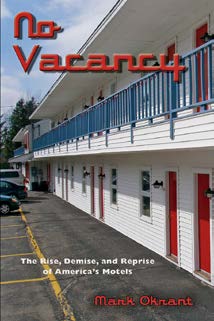No Vacancy: The Rise, Demise, and Reprise of America’s Motels
By Mark Okrant, illustrations by Laura Hodgdon
Concord, New Hampshire: Plaidswede Publishing, 2013
138 pages, illus., $15.95 paper
Keith A. Sculle
 Author Mark Okrant has launched readers on another nostalgic journey where small roadside lodgings serviced travelers overnight. In the introduction, he states of this book and its predecessor, Sleeping Alongside the Road (2006) they offer “a nostalgic look at the American motel, an American icon that is indelibly etched in the memories of nearly half of all Americans age forty and older” (p. ix).
Author Mark Okrant has launched readers on another nostalgic journey where small roadside lodgings serviced travelers overnight. In the introduction, he states of this book and its predecessor, Sleeping Alongside the Road (2006) they offer “a nostalgic look at the American motel, an American icon that is indelibly etched in the memories of nearly half of all Americans age forty and older” (p. ix).
Okrant blends more than reverie, however, in this installment investigating three intellectual criteria. The first chapter labeled “Rise,” is a sketch of motel history. Evidence of the motel’s declining popularity is chapter two’s subject, headed “Demise.” Proposed strategies for the preservation of surviving motels is the
subject of chapter three’s title, “Reprise.” Okrant’s rich mixture of scholarship and literature should not surprise readers. As professor emeritus of tourism management at Plymouth State University (New Hampshire), past president of the Travel and Tourism Research Association, and author of six murder mysteries—four of
them that he labels “tourism-centered”— he offers rare talent. Take, for example, his credible simplification of the various early automobile-stimulated lodgings, the auto camp, cabin camp, and cottage court, before elaborating on the motel which rose in the 1930s and matured in the late-1940s through the 1960s. He poises midway in this history with an imagined explanation for how a farmer and his wife concluded that their wayside lodging and produce stand for travelers could increase the sales of farm goods. Okrant then provides a definition, photographs of specific examples, and generalized diagrams on the motel’s evolution.
“Rise” has two subsections: “Past Patrons’ Views” composed of 33 first-hand customer experiences, and “The Proprietors’ Views” in which 26 motel operators relate their experiences. New Englanders constitute most of the operators, but the patrons are distributed throughout the continent including one from Alaska. Noticeably, however, everyone’s full name has been reduced to initials, likely to shield them against an unwarranted reference.
“Demise” is initiated with two recollections, that of a motel manager and two lodgers. Eleven photographs provide motel examples. Four locations are given detailed attention rooted in websites, interviews, and books; including telephone and business directories.
“Reprise” is launched with a discussion of who has saved and maintained motels to date. Many proprietors have been immigrants, especially Indians ironically named “Patel,” which means “innkeeper of the land” (p. 103). Often, the Indians avoid the title “motel” in the business name. Puerto Rico has saved many old motels “for covert sexual liaisons” (p. 104). The Route 66 corridor in Illinois benefitted from the efforts of John and Lenore Weiss, who saved numerous landscape features after the Route 66 Association of Illinois began in 1989. Okrant himself learned the importance of landscape care when a building burned the morning after he visited it.
Okrant then documents the Retro tour Preservation Project, of which he was a founder, along New Hampshire’s U.S. Route 3. This project encourages motel owners to feature architectural elements of the 1950s–60s, educates them about their importance, and creates a poster that embodies each motel’s history. Maggie Stier, of the New Hampshire Preservation Alliance, details existing federal programs that are relevant to motel preservation. A 1999 National Park Service technical assistance and grants program for Route66 follows. These build to a climax: this book is a call to future missionary work not only for motels but “other mid-twentieth century tourism businesses as an integral, functioning … element of the travel industry well into the future” (p. 137).
A newcomer to commercial archeology will find this book a winsome and reliable entrée to one of the roadside staples, while existing enthusiasts and scholars will respect the treatment and approve the addition of actual motel experiences. Generalizations must be born of case studies, and Okrant has earned a respectful standing from persistent observation and reflection over two decades. His offering on preservation strategies will make this a handbook for the motel’s deserving installment.
Keith A. Sculle dates his first work in commercial archeology to 1974. He was the SCA editor shortly after its founding and has authored and co-authored numerous publications about commercial archeology.
This book review originally appeared in the SCA Journal, Fall 2018, Vol. 36, No. 2. The SCA Journal is a semi-annual publication and a member benefit of the Society for Commercial Archeology.
More Book Reviews

